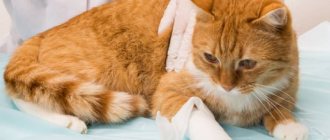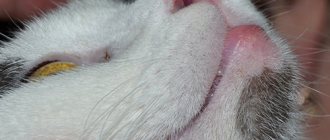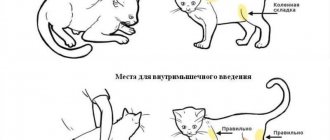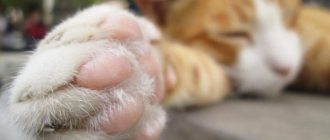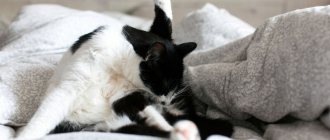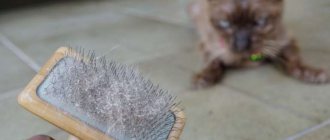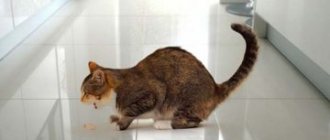It is not without reason that loving owners call their pets “tailed”: this part of the body is truly prominent in every cat and allows your pet to demonstrate an incredible range of emotions. Any breeder knows that tail twitching is not a good sign, indicating that your cat is not in a good mood. But this part of the body is much more important and is not just a “mood barometer”, as many people think. Moreover, a “sick” tail in cats is not such a harmless phenomenon. Any injuries or other pathologies are fraught with serious health problems.
What is a tail even for? As we have already noted, it is needed not only so that the cat can express its emotions. Firstly, everyone knows about the incredible grace and dexterity of all cats. This is largely due to the tail: it plays the role of a balancer and rudder, helping the animal maintain balance in any conditions. Cats that have lost their tail evoke involuntary pity: they cannot run along the fence with the same dexterity, and even when simply running, their “loin” gets carried away a lot.
What are the dangers of tail injuries and diseases?
Often, “experienced” breeders believe that a tail injury is not at all a reason to contact a veterinarian. Like, “it will heal just like that”, “it does not pose a danger to the health of the animal.” Of course, in the case of minor injuries, this is partly true, but still leaving such pathologies without attention is not the best idea.
Some amateurs will agree with this: supposedly inside the caudal vertebrae there is... a spinal cord, damage to which is fraught with extremely serious consequences. Fortunately, there is no spinal cord there . Otherwise, how would cats live if, for one reason or another, they lost this part of their body?!
But still, the erroneous point of view, no matter how strange it may seem, has a rational grain. Yes, there are no vital areas of the central nervous system in the tail, but at the same time, the caudal vertebrae are directly connected to the sacral region, which actually contains the spinal cord... Simply put, if festering wounds in the tail are not treated, the consequences can be very diverse, up to complete or partial paralysis of your pet’s body. You shouldn’t joke with these pathologies, and you shouldn’t take them seriously either.
Prevention
In order not to guess why a cat has a bump on its tail or any other formations, it is best not to let the animal go outside unnecessarily, especially in the spring. If this is not possible, and the pet still goes for walks periodically, then in this case it is recommended to purchase a special collar, the smell of which will drive away parasites.
To exclude most other problems, you need to review the animal’s diet and balance it so that the cat receives all the necessary mineral components and vitamins. However, allowing obesity is also not recommended.
Sometimes bumps of this type are congenital. They become noticeable immediately after the kitten is born. In this case, the defect does not affect the condition of the animal in any way, so there is no cause for concern. But it’s better to play it safe and rule out other pathologies.
Mechanical injuries
One of the most common groups of pathologies. Most often, something wrong happens to the tails of cats that regularly walk outside. It happens that pets get their tail pinched by a door, in other cases they lose it in fights with other cats or as a result of dog attacks. It happens that cyclists or children run across a tail carelessly laid out on the road... In short, there are a lot of causes of mechanical injuries.
It is easy to notice them: the tail becomes “flaccid”; the cat cannot (and does not want, since it is in great pain) to move it. Please note that not all cases show visual signs of crushing or fracture. At first glance, the organ may appear intact.
The clinical picture is quite specific and easily noticeable:
- When trying to take a cat's tail, its owner reacts extremely nervously and even aggressively.
- The organ can be bent at a completely unimaginable angle to the horizon.
- In the most severe cases, when the injury was really serious, not limited to the tail, urinary/fecal incontinence may occur. This is a very bad sign, indicating either some kind of infection (in advanced cases), or damage to the sacral spine.
Diagnosis and treatment
The specialist will carefully examine your pet's tail and also conduct a series of neurological tests. The latter make it possible to understand whether the animal’s nervous system is damaged. In particular, if the cat has no tail sensation at all, treatment options will be limited.
The following types of diagnostic tests are recommended:
- Complete blood test, including checking its biochemical status.
- Analysis of urine.
- It is necessary to perform radiographs of the sacral and caudal spine. Often, after taking a photo, it becomes clear what exactly happened to the pet.
Treatment, as we said above, depends on the underlying cause identified by a veterinarian.
- In cases where the injury is not serious (mild bruise), simple rest will help.
- In more severe cases, it is often necessary to resort to amputation of the affected part of the body.
Note that when the tail is dislocated, it is often possible to confine itself to its reduction: other medical care (as a rule) is no longer required after this. Even with wounds, it rarely comes to surgery. If, of course, the owners at least somehow provided assistance to their pet.
How cats communicate using their tails
It is not always possible to understand from the face how to determine the mood of the animal and figure out what the cat wants. And it is the cat’s tail that will tell you about all the thoughts and emotions of the pet. Let's look at specific examples of why and how a cat twitches its tail:
- The four-legged pet smoothly swings its tail horizontally in different directions. Cat experts indicate this gesture as the fact that she cannot immediately make a choice between her desires. When the decision is made, the animal will calm down and stop twitching;
- if a cat lifts its tail and puts it vertically, it tells you that the pet’s thoughts are very interested in something;
- a slight twitch indicates strong affection and love for you;
- if the cat’s fifth limb is down, it means that she is bored;
- the tail is up, but the back is arched and the ears are pressed back - the cat cannot decide whether to attack or defend. He is very scared;
- the tail is in a curved arc position and the cat arches its back - it senses danger and is ready to defend itself. In this state, do not hit her and try to calm her down;
- a tail raised up (vertically) indicates that the animal is in a great mood and is ready for games and communication;
- a loosely drooping tail tells that the pet is in a calm mood, but is not inclined to communicate;
- a measured and rather strong horizontal waving of the tail indicates dissatisfaction and irritation;
- a wary animal's tail is lowered and ruffled;
- only the tip of the tail moves slightly - at the moment the pet is in an excellent mood and is happy with everything that is happening around him;
- the cat’s tail trembles and moves horizontally in different directions faster and faster - the hunt is in full swing and an attack on the prey will occur in the coming seconds;
- a vertically extended, quivering tail denotes a playful mood. It’s worth considering here that if the movements become faster and sharper, the cat beats its tail and may start meowing - the animal is getting too excited and it’s time to stop it. This is especially true when playing with small children - the danger of scratches and bites from a cat is too great;
- a tail wrapped in a ring around the body speaks of an excellent mood and trust in the surrounding world;
- the tail is raised halfway - the pet is confused and cannot determine its attitude towards a person or animal - to understand whether it is a friend or an enemy;
- fluffy tail and fur along the spine - the cat is furious;
- a vertically raised tail may mean that the cat is marking territory;
- sharp waving or tapping indicates stress and possibly pain;
- biting the tail signals the presence of parasites;
- in cold weather, cats wrap their tail in a ring around themselves, thereby reducing heat transfer;
- a vertically raised tail with a relaxed tip indicates joyful excitement;
- sits or lies with the fifth limb calmly extended - the cat is resting;
- in a sitting position, with paws tucked and tail wrapped - the animal is relaxed, but waiting for some action;
- a slight twitching of the whole body along with the tail means happiness and calmness of the pet. You can observe this when stroking it, scratching its ears or back. Will also be expressed in loud purring and squinting of the eyes;
- a leisurely and rhythmic twitching of the tail vertically indicates interest in something. The cat is relaxed, does not feel danger and is concentrated on the object of its attention. It is also expressed in the fact that the animal walks around the object of its interest and sniffs it;
- the desire to attack can be expressed in walking the fifth limb from side to side. If this occurs when playing with inanimate objects, then there is no need to worry. As soon as the cat gets tired of this activity, it will move away from it and forget about it quite quickly. At least until the next surge in gaming activity.
Cats move their fifth limb almost constantly. There are many explanations for this fact.
When communicating, you just need to pay attention to your pet’s mood. When there is mutual understanding between the owner and the pet, when they can understand and feel each other, then there will be practically no problems in communication
Just listen to what your cat is telling you. Indeed, contrary to popular belief, tail twitching can also mean great love and devotion towards you.
>What to do if your cat has a hanging tail
Features of wound treatment
In case of serious wounds to the tail, accompanied by severe and profuse bleeding, we would advise not to engage in “amateur activities”, but to immediately show the cat to a veterinarian.
A specialist will be able to immediately determine the severity of the injury. Secondly, it is necessary to immediately cut the affected area of the body so that the wound is clearly visible and can be properly cared for.
We strongly recommend using scissors with rounded ends for this purpose. This will prevent additional injury to the skin. After freeing the edges of the wound and some of the skin nearby, clean off blood and other debris using a cotton pad soaked in sterile saline solution. After this, you can lubricate the edges (but not the wound itself!) of the wound canal with alcohol tincture of iodine.
Take a good look inside. If bones or bone fragments are clearly visible in the thickness of the wound, further independent treatment is not advisable: we advise you to contact a veterinarian as soon as possible.
In cases where the injury is not so serious, you can try to cope with the problem yourself. Light abrasions and wounds can simply be covered with a bandage, but not everything is so simple: most likely, your cat’s tail was not injured in the operating room, and therefore the wound canal is inevitably contaminated with microflora. Simply put, the tail will quickly become inflamed.
To avoid this, it is necessary to use Vishnevsky’s balsamic liniment, or synthomycin liniment. Ichthyol ointment has also proven itself well. These are very simple, cheap, but still extremely effective remedies.
They are also easy to use. First, soak a gauze pad with the ointment, and then apply it over the wound (previously cleaned of hair and other contaminants). To prevent the napkin from rolling off, it is fixed by making a tight bandage.
And this is where problems can arise: if you simply put a bandage on the tail, the bandage will soon fly out of its place, and therefore there will be no use from it. To prevent this from happening, you need to start bandaging from the tip of the tail (more precisely, closer to it), lifting the bandage upward in a spiral, towards the root of the tail.
Another problem is cats' tendency to rip off any bandages. If the cat constantly frees its tail from the bandage, it will take a very long time to treat it, and without any special guarantees of success. When your pet is particularly active and impatient, we highly recommend that you immediately consult a veterinarian and place a surgical collar on the animal's neck.
If for some reason this is not possible, you can lubricate the outside of the bandages with something bitter and very unpleasant to the taste. For example, pure ichthyol (which, among other things, has a pronounced anti-inflammatory effect) is suitable.
When to resort to radical methods of treatment?
If your cat cannot feel its tail (that is, does not react in any way to its pin pricks) and has urinary and fecal incontinence, there is no point in engaging in “self-medication”.
All these signs indicate a truly serious injury, which resulted in damage to the sacral spine and spinal cord.
In addition, this happens in advanced cases of tail injuries, when the infection in the blood vessels of the organ begins to spread higher. In such situations, it is recommended to urgently remove the affected body part surgically. Of course, a tailless cat will lose some of its agility and grace, but will remain alive.
Serious injuries to a cat's tail can cause the cat to experience (sometimes lifelong) problems with urination and defecation. It is necessary to prescribe diuretics and stool softeners (as well as laxatives). When things get really bad, it comes down to indwelling urinary catheters.
First aid
In case of an open form of injury, first of all, it is necessary to remove protruding foreign objects, dirt and sharp bone fragments from the wound channel, and stop the bleeding. This can be done by pressing a clean cloth wrapped around your finger against the wound.
After treating the wound and stopping the bleeding, the owner should begin fixing the damaged limb. A small board, a wide ruler, or a plastic panel will be suitable as a tire. The fixation device should be slightly longer than the limb itself.
READ What is the name of grass for cats, how to plant and grow it
Scheme for bandaging a cat's paw
The damaged paw should be secured to the splint using a bandage, belt, belt, or tape. The bandage should be tight, but not squeezing the blood vessels. Bandaging is not carried out in the area of an open wound.
Veterinary experts do not recommend that owners independently use painkillers for fractures. This is due to the fact that without feeling pain, the animal can cause even more harm to itself, aggravating its situation. Pain relief can smooth out the clinical picture of the injury. In addition, the pet will need sedation for X-ray examinations, and pre-administration of an analgesic will adversely affect the cat's health.
After providing competent first aid, a sick pet must be transported to a specialized facility as quickly as possible. For this purpose, thick cardboard, a piece of plywood, boards, a panel from a car, etc. will be suitable in the field.
It is important that the surface is smooth and hard
Cauda equina syndrome
In general, this pathology can be partly considered a type of severe trauma, since sometimes its symptoms develop against their background. But not always. So, what is a ponytail? This is the name for a set of various disorders (i.e., a syndrome) that lead to a “sagging” tail in a cat. The organ often takes the form of a rope attached to the cat. In addition, the pathology in many cases is accompanied by complete or partial paralysis of the rear part of the cat’s body.
What are the reasons for the development of such a severe pathology? They are also very serious: starting from the same injuries of the sacral region, which led to damage to the spinal cord, ending with oncology and autoimmune diseases.
Accordingly, the appearance of a ponytail in a cat is a reason for an urgent visit to the veterinarian. Delay can be fatal.
Causes
Disease on a pet's tail can occur for various reasons. Often these are: long-standing injuries, severe bruises, wounds, fractures or any other damage. Sometimes, but there are still diseases that are quite difficult to determine. These include: tumors, unknown neoplasms, eczema, osteomyelitis. Any of them requires high-quality qualified treatment in compliance with all requirements and recommendations of a veterinarian. Every loving owner should know why such diseases occur and how to deal with them.
© shutterstock
Seborrhea (dry and oily)
If your pet suddenly starts smelling like a dog, so much so that it becomes difficult to be in the same room with the cat, do not rush to accuse him of being unclean. It is possible that your pet suffers from seborrhea. This is a disease characterized by impaired sebum secretion. If too much of it is secreted, then seborrhea is, accordingly, called “oily.” With insufficient secretion of sebum, a dry type of the disease develops.
Veterinarians are still arguing about the causes of the disease , but to this day many cases must be considered idiopathic, since not a single study has helped to identify a single predisposing factor. In cats, the most common is the “fat” variety.
The clinical picture is quite characteristic . In addition to the unpleasant odor already mentioned above, numerous dandruff appears on the animal’s skin and fur (with the dry variety), or the cat’s tail resembles an unsightly icicle. In the latter case, this happens because the sebum released in incredible volumes simply sticks the hair together.
Please keep in mind that this disease, once it appears, is sure to recur later. As a rule, it takes a lifetime to treat.
The intervals between relapses (with proper feeding and good living conditions) can reach several months.
The main predisposing factors are:
- Temperature changes, as well as keeping the cat in rooms with excessively dry air (which is typical for all apartments with central heating).
- It is believed that one of the main reasons for the development of seborrhea in many cases is a variety of allergic reactions.
- The same can be said about diseases of fungal etiology. Pathogenic fungi and yeast have a very bad effect on the condition of the skin.
- “Raw” or “oily” seborrhea is a common consequence of severe hormonal disorders. In particular, it often appears with problems with the thyroid gland.
- Obesity. Firstly, in cats it can also be a consequence of problems with the endocrine glands. Secondly, a “swollen” cat is simply physically unable to take proper care of itself, which makes it much easier for pathogenic fungi to invade its skin. In addition, in such cases, the animal may not have seborrhea, and greasy skin is only a sign of its extreme neglect.
- Diseases of the gastrointestinal tract. If the body does not receive the proper amount of nutrients, micro- and macroelements, the likelihood of developing any diseases becomes many times higher.
- Skin diseases of tick-borne etiology. As a rule, the activity of these parasites leads to the development of a dry type of the disease: mites, gnawing through the outer layers of the skin and actively developing in them, interfere with the normal functioning of the body.
Symptoms and treatment
The symptoms are quite specific, and therefore, as a rule, there are no particular difficulties in identifying the disease. First of all, it is the tail that is affected, which as a result either becomes covered with dandruff, or takes on the appearance of a “greasy icicle.” Abundant dandruff rashes can be found in places where the animal likes to rest; they also become heavily greasy in the case of the oily type of pathology.
Another characteristic sign is very specific, sharp and extremely unpleasant. Experienced owners or veterinarians are able to make a diagnosis as soon as they smell this “aroma.” Note that seborrhea itself does not produce any odor - it is a consequence of the activity of secondary microflora.
As for treatment, it is primarily aimed at eliminating the identified root cause of the disease. Idiopathic seborrhea is treated with special shampoos, which can be purchased at any large pet store. We would recommend consulting with your veterinarian first. It is better when the shampoo is selected by an experienced specialist.
The following products have proven themselves to be effective:
- "Tea tree". It degreases the skin well and has a pronounced anti-inflammatory effect.
- Additionally, any antiparasitic shampoo. It is used in cases where the disease is caused by the activity of fleas, ticks, or other ectoparasites.
- Accordingly, when the disease is fungal in nature, shampoos with an antifungal effect are used.
Symptoms of the disease
It is believed that cats are more susceptible to this disease than others, but it can also occur in cats. Moreover, some breeds are more at risk than others of developing such an unpleasant and difficult-to-treat disease. For example, the Scottish Fold cat is often noted to have a hard tail, while according to breed standards its mobility is especially valued. With such a disorder, a “greasy tail” may also occur.
But the Persian cat is more susceptible to acne, which causes her not just discomfort, but can cause a serious illness. In addition, representatives of any breed, and even outbred cats, can have a fat tail.
In short-haired or “hairless” breeds, it is much easier to detect such a defect, but it is much more difficult to detect it in an animal with a luxurious, bushy tail. Most often, it is discovered by chance, when the process has already started and done its dirty deed.
Greasy tail syndrome is accompanied by the following symptoms:
- The fur at the base of the tail becomes very greasy, covered with thick secretions, which are very difficult or impossible to wash off using simple methods, at least from the first approach.
- On the skin at the base of the hairs you can see tubercles, which can be inflamed, covered with rough scales, and a purulent crust.
- When the disease is advanced, a whole scattering of inflamed pimples or scars from scratching may be found on the skin.
- When the fur suffers from greasy hair, it can break off at the base, leaving the affected area exposed or looking as if the hair has been clipped or pulled out.
- When the anal glands are inflamed, the animal tries to get rid of their excess contents by crawling with its backside on the floor, and sometimes on the carpet.
- With acne, a greasy yellowish spot first appears on a cat's fur, then a “black dot”, and in the absence of care and treatment, a hard crust forms, under which there may be an inflamed or abscessing acne.
Taking care of our pets
Every cat owner should have a clear idea of what diseases he may encounter in his animal. Veterinarians often advise washing cats' anal openings with soap and water. This procedure has a stimulating effect on the anal glands, helping them to cleanse themselves. We also appeal to attentive owners who take their pet for examination at an animal care center - remind the veterinarian about a routine examination of the secretion sacs.
Since the animal experiences pain and shows aggression when performing manual manipulations to remove secretions, it is recommended to contact a specialist. At the Ya-Vet help center, experienced doctors will show you professional, fast help at low prices for your pet. We show love to animals by keeping them healthy!
Dog owners are well aware of possible problems with the anal glands. These are the characteristics of the canine family. However, there is a lot of information about cats. Inflammation of the paraanal glands in cats is not such a common occurrence, since canines and cats are anatomically and physiologically different, although both are human pets.
Ulcers
More often, ulcers occur in short-haired four-legged friends. They can appear along the entire length of the tail, often affecting the root, and this can cause necrosis of the tissues and vertebrae of the tail.
An ulcer on the tail requires serious treatment and attention from the owner. If a crust has formed on it, then it must be removed from there and the wound must be cleaned of suppuration. Be sure to treat everything with an antiseptic for cats. Also, it is worth treating it with ointment (Vishnevsky, streptomycin) and applying a bandage.
© shutterstock
In advanced cases, the cat may develop gangrene, blood poisoning and serious consequences.
Drugs used
To successfully treat an animal, the use of any one remedy is not enough. Therapy must be comprehensive. Medicines should be used both internally, to suppress microflora, and locally.
Ointments
Ointments and liniments have a fatty base, which contributes to:
- rapid absorption of the active principle;
- preventing drying out of serous and mucous membranes;
- softening of tissues, as well as dried “crusts” and their rejection.
If there are no wounds or tears, there is no point in using ointments. Some substances can be absorbed through the skin, but no strong effect is felt.
If there is an abscess or purulent cavity, then applying ointments will help relieve inflammation, but at the same time it is necessary to remove the purulent masses and excise the pockets so that the contents do not linger.
The inconvenience of using ointments for the sub-tail area is that the cat sits down and wipes the ointment on the floor and bedding.
It’s a completely different matter when the drug “Olazol” is used. When shaking the bottle, a foamy mass forms. Through the nozzle it can be easily inserted into the lumen of the rectum. By doing this regularly, you can quickly create the necessary concentration of the active principle in the tissues and relieve inflammation. The base is chloramphenicol and sea buckthorn oil. The drug is effective for paraproctitis and the cat recovers quickly.
The following can be used as ointments:
- levomekol;
- levosin;
- chloramphenicol - gel;
- syntomycin liniment;
- gentamicin ointment.
The ointment should be applied at intervals of 1-2 hours into the wound cavity. If there is no wound, then apply the ointment alone to a cotton swab and insert it into the cat’s rectal cavity. You should change your tampon 2 times a day.
Antibiotics
A course of antibiotics is necessary to suppress the infection and lasts 5-7 days, depending on the severity of the process.
The most effective drugs are:
- cephalexin. If the drug is in capsules, then the gelatin base contains a powder that is very easy to dose. For an average cat, you can take 1/10 of it, mix it with minced meat and apply it to the root of the tongue. The tablet form is turned into powder or 1/10 of the tablet is broken off and served to the cat. The drug is well absorbed and retained in soft tissues and acts against many microorganisms. The drug is administered 2 times a day in a mixture with food;
- ciprafloxacin. The group of fluoroquinolones to which the drug belongs is able to quickly cope with the onset of infection and relieve inflammation from soft tissues. The drug is in tablet form. For a cat, the tablet is divided into 10 parts and placed in the mouth in one part in the morning and in the evening.
Rectal suppositories
The described pathology is localized in the rectum and the use of rectal suppositories is advisable.
The following drugs may be most effective:
- “Ichthyols”, based on ichthyol;
- “Propolis” containing propolis;
- "Proctosedil", with antibiotics and hydrocartisone
- "Olesthesin" with sulfonamides and sea buckthorn oil.
Suppositories are administered 2 times a day after bowel movements.
The danger of skin pathologies for humans
Despite the fact that such diseases are an unpleasant phenomenon, most of them are not transmitted to people. Timely and correct prescription of medications makes them not dangerous for their owners.
Infection with different types of lichen and allergic reactions from blood-sucking bites require the use of medications not only for the animal, but also for the owner. They do not pose a threat to life, but the spread of scabs and ulcers throughout the body of a person or pet is not a very pleasant phenomenon, and it needs prompt treatment.
